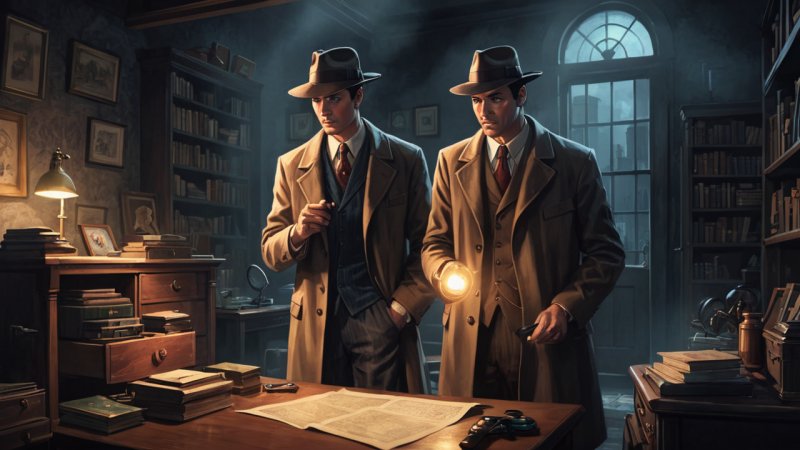The detective's sidekick is a staple of mystery and thriller literature, often overshadowed by the brilliance of the lead detective. Yet, these characters play a crucial role in shaping the narrative, providing support, comic relief, and sometimes even the crucial insights needed to solve a case. This article explores the multifaceted role of the sidekick in mystery stories, examining their characteristics, significance, and evolution across various literary genres.
Understanding the Sidekick Archetype
The archetype of the sidekick has deep roots in literature, dating back to classical mythology and folklore. In mystery stories, the sidekick serves not only as a companion to the detective but also as a narrative device that helps to reveal aspects of the protagonist's character. Typically, sidekicks exhibit several key traits:
- Supportive Nature: Sidekicks often provide emotional and logistical support to the detective, helping to alleviate the burdens of the investigative process.
- Contrasting Personality: Many sidekicks possess characteristics that contrast with those of the detective, allowing for a dynamic interplay that enriches the storytelling.
- Comic Relief: In a genre often steeped in tension and suspense, sidekicks frequently inject humor, lightening the mood and making the narrative more accessible.
- Intuitive Insights: Although they may not be as skilled or perceptive as the main detective, sidekicks often provide valuable perspectives that can lead to breakthroughs in the case.
Historical Context: The Evolution of the Detective's Sidekick
The role of the detective's sidekick has evolved significantly over the years, reflecting changes in societal norms and literary trends. Early examples can be found in works like Sir Arthur Conan Doyle's Sherlock Holmes series, where Dr. John Watson serves as both confidant and chronicler of Holmes's adventures. Watson’s unwavering loyalty and contrasting demeanor highlight Holmes's eccentricities, enriching the narrative.
In the 20th century, sidekicks began to take on more diverse roles. Characters like Captain Hastings in Agatha Christie’s Hercule Poirot series not only assisted in investigations but also represented the average person, allowing readers to engage with the story more easily. This shift allowed the sidekick to become more than just a helper; they became a gateway for readers to explore the intricate world of mystery.
Notable Detective Sidekicks in Literature
Various sidekicks have left an indelible mark on the mystery genre, each adding unique elements to their respective narratives. Here are a few notable examples:
Dr. John Watson (Sherlock Holmes Series)
As mentioned earlier, Watson is perhaps the most iconic literary sidekick. His unwavering loyalty, medical expertise, and everyman perspective allow readers to navigate the complex world of Holmes’s investigations. Watson's narrative voice provides clarity and context, making Holmes's feats of deduction all the more impressive.
Captain Hastings (Hercule Poirot Series)
Another classic sidekick, Hastings provides a counterbalance to Poirot’s meticulous nature. While Hastings often lacks Poirot's acute observational skills, his military background and straightforward thinking offer a different approach to problem-solving. Hastings’s perspective often serves to highlight Poirot's genius, making their partnership compelling.
Inspector Lestrade (Sherlock Holmes Series)
Inspector Lestrade serves as a foil to Holmes, representing the traditional law enforcement approach to detective work. While often depicted as bumbling or slow-witted, Lestrade’s character evolves throughout the series, demonstrating that even those in authority can learn from unconventional methods.
Sam Spade's Sidekick (The Maltese Falcon)
In Dashiell Hammett’s classic, Spade's sidekick is not a traditional partner but rather a reflection of the gritty realism of noir fiction. The dynamics between Spade and his associates reveal much about the moral complexities of the characters and the world they inhabit.
The Importance of the Sidekick in Narrative Development
Sidekicks play an essential role in developing the narrative arc of mystery stories. Their interactions with the detective often serve as catalysts for character development and thematic exploration. Here’s how:
Character Development
Through their relationships with the detective, sidekicks often undergo significant development. For example, Watson evolves from being a mere observer to a trusted confidant and partner. This growth adds depth to both characters, making their partnership more relatable and compelling.
Thematic Exploration
Sidekicks often embody themes central to the narrative. They can represent loyalty, morality, or the struggle to comprehend a world rife with deception and intrigue. Their unique perspectives allow for a more nuanced exploration of these themes, inviting readers to reflect on broader societal issues.
Driving the Plot
Sidekicks often introduce subplots that complement the main narrative. These subplots can provide comic relief, deepen emotional stakes, or introduce new conflicts that challenge the detective. For instance, sidekicks may find themselves embroiled in personal dilemmas that intersect with the primary investigation, adding layers to the plot.
Modern Takes on the Detective's Sidekick
In contemporary literature, the role of the sidekick continues to evolve, reflecting modern sensibilities and diverse perspectives. Many authors are redefining the sidekick archetype, presenting characters with agency and complexity.
Diverse Representation
Modern sidekicks often reflect a broader range of backgrounds and experiences, enriching the narrative landscape. For example, in the Detective Cormoran Strike series by Robert Galbraith (J.K. Rowling), Robin Ellacott serves as a capable partner who often challenges traditional gender roles in detective fiction.
Complex Relationships
Contemporary authors are also exploring the complexities of relationships between detectives and their sidekicks. The emotional depth and intricacies of these partnerships add realism and relatability to the stories. For instance, the dynamic between Nick and Amy Dunne in Gillian Flynn's *Gone Girl* showcases how partnerships can be fraught with tension and moral ambiguity.
Conclusion: The Lasting Legacy of the Detective's Sidekick
The detective's sidekick is more than just a supporting character; they are integral to the fabric of mystery literature. From enhancing character development to driving the plot, sidekicks play diverse and significant roles in shaping narratives. As literature continues to evolve, the sidekick will undoubtedly adapt, reflecting broader cultural shifts and the changing landscape of storytelling. Their enduring presence serves as a testament to the importance of collaboration, friendship, and the shared pursuit of truth in the often murky waters of mystery.






